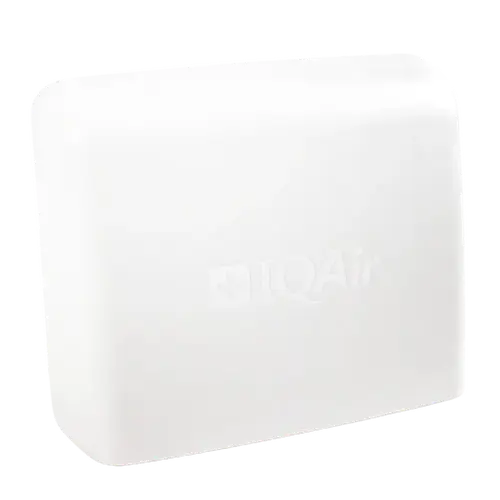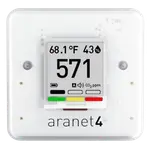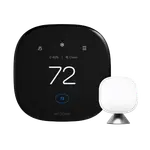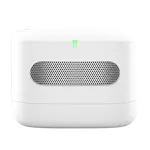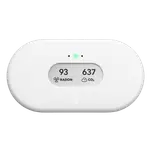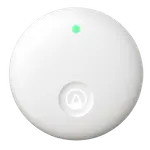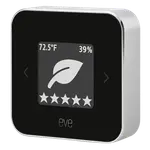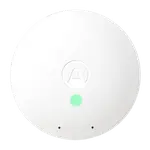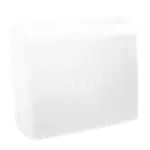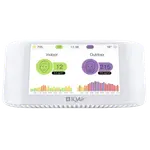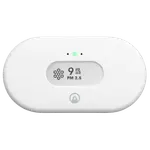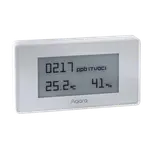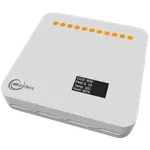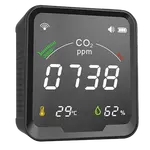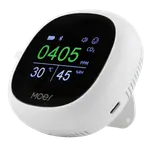IQAir
AirVisual Outdoor
Launch Year: 2021
Summary
Size & Materials: 162 x 69 x 202 mm, Weather Resistance
Power: Wired
Connectivity: 2.4 GHz Wifi, Ethernet
Sensors: PM1, PM2.5, PM10, CO2, Temperature, Humidity, Atmospheric Pressure
Alerts: Air Quality Alerts
Features: History Records
Price History
Loading price history...
| Brand | IQAir |
|---|---|
| Headquarters | |
| Website | https://www.iqair.com |
| @IQAir |
Size & Materials
Devices are typically rated using the Ingress Protection (IP) scale, which indicates the level of protection against dust, solid particles, and moisture.
An IP rating (Ingress Protection rating) is a standardized way to describe how well a device is protected against solids (like dust) and liquids (like water). The rating consists of two digits:
- The first digit represents protection against solid particles (e.g., dust).
- The second digit represents protection against liquids (e.g., water).
First Digit (Protection Against Solids):
- IP0X: No protection against solid objects.
- IP1X: Protection against solid objects larger than 50 mm (e.g., accidental touch by hand).
- IP2X: Protection against objects larger than 12.5 mm (e.g., fingers).
- IP3X: Protection against objects larger than 2.5 mm (e.g., tools or thick wires).
- IP4X: Protection against objects larger than 1 mm (e.g., thin wires or small tools).
- IP5X: Dust-protected. Limited ingress of dust is allowed, but it won't interfere with operation.
- IP6X: Dust-tight. Complete protection against dust, ensuring no ingress of particles.
Second Digit (Protection Against Liquids)
- IPX0: No protection against water.
- IPX1: Protection against vertically falling water droplets (e.g., light rain).
- IPX2: Protection against vertically dripping water when tilted up to 15°.
- IPX3: Protection against water sprayed at an angle of up to 60° (e.g., light splashing).
- IPX4: Protection against water splashes from any direction.
- IPX5: Protection against water jets from any direction (e.g., a garden hose).
- IPX6: Protection against powerful water jets (e.g., heavy rain or washing with a hose).
- IPX7: Protection against temporary immersion in water up to 1 meter deep for up to 30 minutes.
- IPX8: Protection against continuous immersion in water beyond 1 meter.
YES (Outdoor)
Length x Width x Height
- Length: the longest side of the device
- Width: the shorter side of the device
- Height: the vertical dimension of the device
162 x 69 x 202 mm
The physical weight of the device, typically measured in grams (g) or ounces (oz).
Weight can be important for installation considerations, especially for wall-mounted or battery-powered devices.
?
Power
Wired air quality monitors are connected directly to your home's electrical system, ensuring a consistent and uninterrupted power supply. This is particularly advantageous for devices that continuously monitor air quality, as they do not require battery changes or recharging.
YES
100 - 240 V AC PoE (power over Ethernet) power adapter
Battery-powered air quality monitors offer greater flexibility in terms of placement. Since they don't rely on electrical outlets, you can easily move them around your home to monitor air quality in different rooms or outdoor spaces.
-
Sensors that connect via Wi-Fi tend to consume more power due to the constant need to maintain a connection with the network, meaning more frequent battery replacements.
Zigbee, Z-Wave, and Thread Sensors are designed for low-power devices, allowing sensors to last much longer on battery power, often up to 3-5 years before needing a battery change.
Bluetooth Low Energy (BLE) sensors have moderate power consumption, offering a reasonable battery life depending on usage.
-
Connectivity
Range: The 2.4 GHz band offers a longer range, meaning it can cover larger areas and penetrate solid objects like walls more effectively than 5 GHz.
Speed: Generally, 2.4 GHz provides slower speeds compared to 5 GHz due to a lower maximum data rate.
Interference: More prone to interference since many other devices (like cordless phones, microwaves, and Bluetooth devices) operate on the 2.4 GHz frequency, leading to potential congestion and slower network performance.
YES
Range: Offers a shorter range compared to 2.4 GHz and may have difficulty penetrating walls and other obstacles.
Speed: Typically provides faster speeds and higher data rates due to more available bandwidth.
Interference: Less prone to interference as fewer devices operate on this frequency, leading to a more stable connection.
NO
Ethernet is a widely used technology for wired networking, providing a stable and high-speed connection between devices on a local area network (LAN).
Speed: Ethernet can offer higher and more consistent speeds compared to Wi-Fi. Modern Ethernet standards can support speeds from 100 Mbps (Fast Ethernet) to 10 Gbps (10 Gigabit Ethernet) and beyond.
Stability and Reliability: Because it uses a wired connection, Ethernet is less susceptible to interference from other devices and physical barriers, leading to a more stable and reliable connection.
Lower Latency: Ethernet typically offers lower latency compared to Wi-Fi, making it ideal for applications that require real-time data transfer, such as online gaming and video conferencing.
Security: A wired connection is generally more secure than a wireless one, as physical access to the network is required to intercept data.
YES
Bluetooth is a wireless communication technology used for exchanging data over short distances.
Bluetooth enables devices to communicate wirelessly within a short range, typically up to 10 meters (about 33 feet) for most consumer devices.
NO
Zigbee is a wireless communication protocol designed for low-power, short-range applications, commonly used in smart home devices, industrial automation, and other areas requiring reliable, low-data rate communication. It features low power consumption, making it ideal for battery-operated devices, and supports short-range communication, typically up to 100 meters. Zigbee employs mesh networking, allowing devices to relay data through each other to extend range and improve reliability. It supports data rates up to 250 kbps, suitable for small data packets, and ensures interoperability among devices from different manufacturers if they conform to Zigbee standards. Security is robust, with AES-128 encryption for data protection.
Z-Wave is known for its low power consumption, making it ideal for battery-powered devices. It supports a mesh networking topology, allowing devices to communicate with each other directly or through intermediary nodes, thus extending the overall network range and enhancing reliability. The protocol supports data rates of up to 100 kbps, suitable for transmitting control commands and sensor data.
NO
Zigbee is a wireless communication protocol designed for low-power, short-range applications, commonly used in smart home devices, industrial automation, and other areas requiring reliable, low-data rate communication. It features low power consumption, making it ideal for battery-operated devices, and supports short-range communication, typically up to 100 meters. Zigbee employs mesh networking, allowing devices to relay data through each other to extend range and improve reliability. It supports data rates up to 250 kbps, suitable for small data packets, and ensures interoperability among devices from different manufacturers if they conform to Zigbee standards. Security is robust, with AES-128 encryption for data protection.
Zigbee devices need a Zigbee-compatible hub to connect and communicate with other devices in your smart home setup.
NO
Thread is a wireless communication protocol designed specifically for Internet of Things (IoT) devices, providing secure, reliable, and scalable networking. Unlike some other protocols, Thread is IP-based, which means it can seamlessly integrate with existing internet infrastructure. It operates in the 2.4 GHz frequency band and uses mesh networking to enhance reliability and extend range by allowing devices to relay data through each other.
Thread is optimized for low power consumption, making it suitable for battery-operated devices. It supports low-latency communication, which is crucial for real-time applications like home automation and security systems. The protocol ensures high security with AES-128 encryption and end-to-end security at the network layer. Thread also supports over-the-air updates, ensuring devices can stay up to date with the latest features and security patches.
Thread-enabled devices require a Thread Border Router (such as certain smart home hubs or routers) to connect to your home network and other Thread devices.
NO
Additional connectivity options not covered by the standard protocols.
This may include proprietary wireless protocols, infrared, or other specialized communication methods.
NO
Display
Indicates whether the device has a built-in display screen.
A screen can show real-time information, settings, and status without needing to check a mobile app.
NO
The type of display technology used, such as LCD, OLED, E-ink, or LED.
Different screen types offer varying levels of visibility, power consumption, and image quality.
-
Indicates whether the display can show colors or is limited to monochrome.
Color screens can display more detailed information and provide a better user experience.
-
Indicates whether the display responds to touch input for direct interaction.
Touch screens allow for easier navigation and control without needing physical buttons.
-
The diagonal measurement of the display screen, typically in inches.
Larger screens are easier to read from a distance but may consume more power.
-
The pixel dimensions of the display, indicating how sharp and detailed the screen output will be.
Higher resolution displays show clearer text and more detailed information.
-
Integrations
Google Home serves as a central hub for a variety of smart devices, including lights, thermostats, cameras, and speakers. It leverages Google Assistant for voice control, enabling users to manage their smart home with simple commands.
NO
Amazon Alexa is one of the most widely used smart home systems, known for its compatibility with a vast array of devices. Users can control everything from smart lights to appliances using voice commands through Echo devices.
NO
Apple HomeKit is designed for users in the Apple ecosystem, providing a seamless way to control compatible smart devices through iOS devices using the Home app or Siri. It emphasizes security and user privacy.
NO
SmartThings is a flexible platform that connects a wide range of devices from different brands, offering a unified interface for control. It supports various communication protocols, allowing for extensive device compatibility.
NO
Home Assistant is an open-source platform that allows for extensive customization and integration of a wide variety of smart devices. It supports a multitude of protocols and brands, making it ideal for tech-savvy users.
NO
IFTTT (If This Then That) is a web-based service that allows users to create simple automation sequences, known as applets, which enable different devices, services, and applications to work together seamlessly. It connects a wide range of products and services, facilitating interoperability and enhancing functionality.
NO
Matter is a unified, open-source connectivity protocol designed to standardize and simplify communication between smart home devices from different manufacturers. Developed by the Connectivity Standards Alliance (formerly the Zigbee Alliance), Matter aims to improve interoperability, security, and reliability across various smart home ecosystems.
Matter operates over existing networking technologies, including Ethernet, Wi-Fi, and Thread, providing flexibility in device connectivity. Its IP-based nature allows seamless integration with existing internet infrastructure and cloud services. Matter uses a mesh networking topology, particularly when operating over Thread, to enhance range and reliability by allowing devices to relay data through each other.
Security is a cornerstone of Matter, with end-to-end encryption and secure device onboarding processes ensuring robust protection for data and privacy. Matter also supports over-the-air updates, allowing devices to stay current with the latest features and security enhancements.
NO
Sensors
Volatile organic compounds (VOCs) are a large and diverse group of compounds that volatilize into the air at room temperature. Inside your home, volatile organic compounds are harmful, carcinogenic air pollutants that evaporate at normal indoor atmospheric conditions.
The majority of indoor VOCs come from everyday household staples, including sprays and aerosols such as air fresheners, cleaners and pesticides. Many products, such as glue, new furniture and carpets, construction materials and electronic devices produce VOCs through off-gassing as well. Your home will release these trapped VOCs and could harm you and your family.
TVOC (Total Volatile Organic Compounds) refers to the aggregate concentration of all VOCs in the air. Instead of measuring each individual VOC, TVOC gives you a general measure of the total level of volatile organic compounds present in a specific area.
NO
PM (Particulate Matter) refers to tiny particles or droplets in the air that can be harmful to human health when inhaled. These particles vary in size, and the smaller they are, the deeper they can penetrate into our respiratory system. PM is categorized by its diameter in microns (µm), and the most commonly measured sizes are PM0.1, PM0.3, PM1, PM2.5, and PM10.
- Size: Particles with a diameter of 0.1 microns or smaller.
- Sources: PM0.1 particles come from combustion processes such as car exhaust, industrial emissions, and even cigarette smoke. They can also originate from indoor sources like cooking or burning candles.
- Health Effects: These ultrafine particles are the most dangerous because they can penetrate deep into the lungs, reach the bloodstream, and potentially affect the heart, brain, and other organs. Long-term exposure may contribute to cardiovascular disease, lung disease, and even neurological disorders.
NO
PM (Particulate Matter) refers to tiny particles or droplets in the air that can be harmful to human health when inhaled. These particles vary in size, and the smaller they are, the deeper they can penetrate into our respiratory system. PM is categorized by its diameter in microns (µm), and the most commonly measured sizes are PM0.1, PM0.3, PM1, PM2.5, and PM10.
- Size: Particles with a diameter of 0.3 microns or smaller.
- Sources: PM0.3 particles come from sources similar to PM0.1 and PM1, including combustion engines, industrial emissions, smoke, and some indoor activities like cooking or burning candles. They also include viruses, bacteria, and fine dust.
- Health Effects: Like PM0.1 and PM1, PM0.3 particles are small enough to penetrate deep into the lungs and potentially enter the bloodstream. Prolonged exposure to these particles can cause respiratory problems, cardiovascular disease, and other health issues.
NO
PM (Particulate Matter) refers to tiny particles or droplets in the air that can be harmful to human health when inhaled. These particles vary in size, and the smaller they are, the deeper they can penetrate into our respiratory system. PM is categorized by its diameter in microns (µm), and the most commonly measured sizes are PM0.1, PM0.3, PM1, PM2.5, and PM10.
- Size: Particles with a diameter of 1 micron or smaller.
- Sources: Similar to PM0.1, PM1 particles mostly come from combustion sources like vehicle emissions, industrial processes, and smoke. They can also arise indoors from cooking, wood stoves, or tobacco smoke.
- Health Effects: PM1 particles can travel deeply into the respiratory tract and reach the alveoli, the tiny air sacs in the lungs where oxygen exchange occurs. Long-term exposure to PM1 has been associated with respiratory issues such as asthma, bronchitis, and chronic lung disease
YES
PM (Particulate Matter) refers to tiny particles or droplets in the air that can be harmful to human health when inhaled. These particles vary in size, and the smaller they are, the deeper they can penetrate into our respiratory system. PM is categorized by its diameter in microns (µm), and the most commonly measured sizes are PM0.1, PM0.3, PM1, PM2.5, and PM10.
- Size: Particles with a diameter of 2.5 microns or smaller.
- Sources: Common sources of PM2.5 include car exhaust, power plants, industrial activities, and outdoor fires, as well as indoor sources like stoves, heaters, and candles. Urban areas with high traffic and industrial activity tend to have higher PM2.5 levels.
- Health Effects: PM2.5 is small enough to bypass the body's natural defenses (like nose hairs and mucus) and lodge deep in the lungs. Prolonged exposure to PM2.5 can lead to respiratory conditions, worsen existing asthma, and increase the risk of heart disease and stroke. It has also been linked to premature death in people with existing heart or lung diseases.
YES
PM (Particulate Matter) refers to tiny particles or droplets in the air that can be harmful to human health when inhaled. These particles vary in size, and the smaller they are, the deeper they can penetrate into our respiratory system. PM is categorized by its diameter in microns (µm), and the most commonly measured sizes are PM0.1, PM0.3, PM1, PM2.5, and PM10.
- Size: Particles with a diameter of 10 microns or smaller.
- Sources: PM10 particles are primarily generated from construction sites, road dust, pollen, mold spores, and certain agricultural activities. Natural sources like sea spray and desert dust storms can also contribute.
- Health Effects: PM10 particles are large enough to be trapped in the upper respiratory system (nose and throat). While they don't penetrate as deeply as PM2.5 or smaller particles, they can still cause irritation in the nose, throat, and lungs, particularly in people with pre-existing conditions like asthma or COPD (Chronic Obstructive Pulmonary Disease).
YES
A colorless, odorless gas that can be deadly in high concentrations. Carbon monoxide is often released by faulty furnaces, gas stoves, or car exhaust. Monitoring CO is crucial in enclosed spaces to avoid poisoning, especially in homes with gas appliances or attached garages.
NO
When it reaches high levels indoors, carbon dioxide (CO2) can cause poor sleep and trouble concentrating.
YES
Nitrogen oxides, particularly nitrogen dioxide (NO₂), are common pollutants from vehicle emissions and industrial processes. They contribute to smog formation and respiratory problems, and long-term exposure can reduce lung function and aggravate conditions like asthma. Monitoring NOx is especially important for those living near highways or industrial areas.
NO
You can't see or smell it, but long-term exposure to this radioactive gas is the top cause of lung cancer in non-smokers.
NO
Temperature is not just a matter of comfort, it can negatively affect sleep quality, mood, and alertness.
YES
High humidity promotes mold growth and aggravates asthma symptoms, while too-dry air can lead to skin and throat irritation.
YES
Changes in air pressure affect radon levels and, for some, they can trigger headaches, joint stiffness and pain.
YES
Measures the amount of light in the surrounding environment.
Ambient light sensors can automatically adjust display brightness or trigger lighting automations based on natural light levels.
NO
Measures ultraviolet radiation levels, which can be harmful with prolonged exposure.
UV monitoring helps you understand when sun protection is needed and can trigger alerts for high UV index levels.
NO
Detects whether a room or area is occupied, based on movement or other triggers.
Occupancy sensors are useful for energy-saving automations and security applications.
NO
Measures the sound levels in the environment, typically in decibels (dB).
Noise monitoring can help you identify when environments are too loud and may trigger health or comfort alerts.
NO
Alerts
Notifications when temperature readings exceed or fall below preset thresholds.
Temperature alerts can help prevent damage to sensitive items and ensure comfortable living conditions.
NO
Notifications when humidity levels become too high or too low for optimal comfort and health.
Proper humidity levels (30-50%) prevent mold growth and maintain respiratory comfort.
NO
Notifications when air quality measurements indicate unhealthy conditions.
Air quality alerts help you take action to improve indoor air, such as increasing ventilation or running air purifiers.
YES
Notifications when the device's battery level becomes critically low.
Battery alerts ensure you can replace or recharge batteries before the device stops functioning.
NO
Features
The ability to create automated actions based on sensor readings or schedules.
Automations can trigger other smart devices, send notifications, or adjust settings without manual intervention.
YES
The ability to track air quality trends over time can help you pinpoint problem areas in your home or recognize patterns in pollution spikes (e.g., during cooking or when using certain household products).
YES
Compare top smart air quality monitors by connectivity, sensors, integrations, alerts, and more. Find the best one for your home.
![Aranet4 HOME]() Aranet
AranetAranet4 HOME
![Ecobee Smart Thermostat Premium]() Ecobee
EcobeeSmart Thermostat Premium
![SwitchBot Meter Pro (CO2 Monitor)]() SwitchBot
SwitchBotMeter Pro (CO2 Monitor)
![Amazon Smart Air Quality Monitor]() Amazon
AmazonSmart Air Quality Monitor
![Airthings View Plus]() Airthings
AirthingsView Plus
![Airthings Wave Enhance]() Airthings
AirthingsWave Enhance
![Eve Room]() Eve
EveEve Room Indoor
![Airthings Wave Mini]() Airthings
AirthingsWave Mini
![IQAir AirVisual Outdoor]() IQAir
IQAirAirVisual Outdoor
![IQAir AirVisual Pro]() IQAir
IQAirAirVisual Pro
![Airthings View Pollution]() Airthings
AirthingsView Pollution
![Aqara TVOC Air Quality Monitor]() Aqara
AqaraTVOC Air Quality Monitor
![AirGradient ONE]() AirGradient
AirGradientAirGradient ONE
![AirGradient Open Air]() AirGradient
AirGradientAirGradient Open Air
![Apollo MSR-2 with CO2]() Apollo Automation
Apollo AutomationMSR-2 with CO2
![Moes CO2 Air Quality Monitor Temp and Hum]() Moes
MoesCO2 Air Quality Monitor Temp and Hum
![Moes CO2 Portable Temp Humi Air Quality Monitor]() Moes
MoesCO2 Portable Temp Humi Air Quality Monitor
![AirGradient Open Air]() AirGradientAirGradient Open Air
AirGradientAirGradient Open Air![AirGradient ONE]() AirGradientAirGradient ONE
AirGradientAirGradient ONE![Airthings View Plus]() AirthingsView Plus
AirthingsView Plus![IQAir AirVisual Pro]() IQAirAirVisual Pro
IQAirAirVisual Pro![Ecobee Smart Thermostat Premium]() EcobeeSmart Thermostat Premium
EcobeeSmart Thermostat Premium![SwitchBot Meter Pro (CO2 Monitor)]() SwitchBotMeter Pro (CO2 Monitor)
SwitchBotMeter Pro (CO2 Monitor)![Amazon Smart Air Quality Monitor]() AmazonSmart Air Quality Monitor
AmazonSmart Air Quality Monitor![Airthings View Pollution]() AirthingsView Pollution
AirthingsView Pollution![Apollo MSR-2 with CO2]() Apollo AutomationMSR-2 with CO2
Apollo AutomationMSR-2 with CO2![Aranet4 HOME]() AranetAranet4 HOME
AranetAranet4 HOME![Airthings Wave Enhance]() AirthingsWave Enhance
AirthingsWave Enhance![Moes CO2 Air Quality Monitor Temp and Hum]() MoesCO2 Air Quality Monitor Temp and Hum
MoesCO2 Air Quality Monitor Temp and Hum![Moes CO2 Portable Temp Humi Air Quality Monitor]() MoesCO2 Portable Temp Humi Air Quality Monitor
MoesCO2 Portable Temp Humi Air Quality Monitor![Eve Room]() EveEve Room Indoor
EveEve Room Indoor![Airthings Wave Mini]() AirthingsWave Mini
AirthingsWave Mini![Aqara TVOC Air Quality Monitor]() AqaraTVOC Air Quality Monitor
AqaraTVOC Air Quality Monitor

